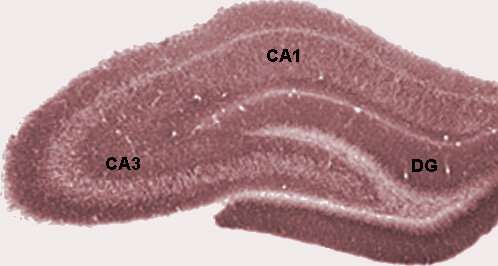March 31, 2020 feature
Neuroscientists gather new insight about the genetic risk of developing schizophrenia

Past research in the field of neuroscience suggests that specific types of cells can contribute to the development of psychiatric disorders, including schizophrenia. However, identifying the types of cells that may play a role in schizophrenia can be quite challenging, particularly when using some of the most conventional techniques for the analysis of human tissue.
Researchers at the Lieber Institute for Brain Development and the Astellas Research Institute of America have recently carried out new study aimed at investigating gene expression in an important type of neuron that could be associated with schizophrenia. In their paper, published in Nature Neuroscience, they profiled gene expression in a region of the brain that has been found to be linked to schizophrenia, namely the dentate gyrus of the hippocampus.
Over the past few years, the same team of researchers conducted several studies with the goal of better understanding molecular correlates of schizophrenia by analyzing human brain tissue collected post-mortem. These experiments were carried out on homogenate brain tissue, which contains a complex mixture of a variety of cell types. While they gathered important insight, the use of homogenate brain tissue seemed far from ideal, as it made it harder to focus investigations on specific cell types hypothetically associated with gene expression signals in schizophrenia.
"Previous research had implicated the dentate gyrus in psychiatric illness and this subregion of hippocampus plays an important role in memory," Daniel Hoeppner, one of the researchers who carried out the study, told Medical Xpress. "In our study, we leveraged the distinct morphological appearance of the granule cell layer, using laser capture microdissection to cut this layer out of the surrounding hippocampus tissue."
The experimental design that the researchers used in their recent work has several important advantages. One of its key strengths is that it involves the use of RNA sequencing (RNA-seq) data from both hemispheres of the same brains; the bulk hippocampus region from one hemisphere and the dentate gyrus granule cell layer from the other.
By analyzing this data, the researchers were able to identify gene expression signatures specific to the granule cell layer of the dentate gyrus (DG-GCL) and others that appeared to be shared with other parts of the hippocampus. These contrasts in the cellular specificity of different parts of the hippocampus were the primary focus of the researchers' analyses.
"From a methodological standpoint, many researchers have moved from homogenate brain tissue directly to individual nuclei using so-called single nucleus RNA sequencing (snRNA-seq)," Thomas Hyde, another researcher involved in the study, told Medical Xpress. "However, these evolving methods still shallowly profile gene expression, particularly from less abundant cell populations. The use of laser capture microdissection allowed us to focus on morphologically—or spatially—defined cell populations and use existing well-established sequencing technologies to deeply profile their transcriptomes."
Using laser capture microdissection combined with RNA sequencing, the researchers were able to identify far more cellular specificity for genes found in genome-wide association study (GWAS) risk loci than those characterized in previous studies. In other words, they identified cell types and genetic effects in the DG-GCL brain region that could be associated with the risk of developing schizophrenia.
The researchers identified approximately 9 million gene expression features in the DG-GCL, 15% of which were unique to this brain region and absent in other parts of the bulk hippocampus. This 15% included 15 expression loci that were previously highlighted as potential schizophrenia risk variants.
By analyzing these findings, the researchers were able to unveil genetic signals associated with schizophrenia that were never identified before, including a decreased expression of genes GRM3 and CACNA1C.
"Identifying novel risk gene associations specifically in the dentate gyrus could ultimately motivate functional experiments to generate hippocampal granule cell neurons from induced pluripotent stem cells (iPSCs) and alter the expression of these risk genes to better understand biological mechanisms of risk," Mitsuyuki Matsumoto, another researcher who carried out the study, told MedicalXpress.
This recent report highlights the vast potential of using targeted sampling strategies, such as laser capture microdissection, to investigate specific cellular patterns in the human brain. The findings gathered by Hoeppner, Hyde, Matsumoto and their colleagues also provide new valuable insight about gene expression patterns that may be associated with the risk of developing schizophrenia.
"Our work suggests that diving deeper into specific cell types of the human brain might be more fruitful for risk gene discovery than additional brain regions of homogenate tissue," Andrew Jaffe said. "The Lieber Institute for Brain Development will thus continue developing laser capture microdissection strategies to profile additional specific cell populations in human postmortem brain tissue. In parallel, we have developed strategies for spatial transcriptomics analyses of human postmortem brain tissue and are now adapting these approaches to study the human hippocampus."
More information: Andrew E. Jaffe et al. Profiling gene expression in the human dentate gyrus granule cell layer reveals insights into schizophrenia and its genetic risk, Nature Neuroscience (2020). DOI: 10.1038/s41593-020-0604-z
Developmental and genetic regulation of the human cortex transcriptome illuminate schizophrenia pathogenesis, Nature Neuroscience (2018). DOI: 10.1038/s41593-018-0197-y
Leonardo Collado-Torres et al. Regional Heterogeneity in Gene Expression, Regulation, and Coherence in the Frontal Cortex and Hippocampus across Development and Schizophrenia, Neuron (2019). DOI: 10.1016/j.neuron.2019.05.013
Kristen R. Maynard et al. Transcriptome-scale spatial gene expression in the human dorsolateral prefrontal cortex, (2020). DOI: 10.1101/2020.02.28.969931
© 2020 Science X Network



















